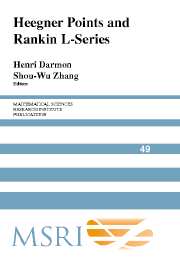Book contents
- Frontmatter
- Contents
- Preface
- Heegner Points: The Beginnings
- Correspondence
- The Gauss Class Number Problem for Imaginary Quadratic Fields
- Heegner Points and Representation Theory
- Gross–Zagier Revisited
- Special Value Formulae for Rankin L-Functions
- Gross-Zagier Formula for GL(2), II
- Special Cycles and Derivatives of Eisenstein Series
- Faltings' Height and the Derivatives of Eisenstein Series
- Elliptic Curves and Analogies Between Number Fields and Function Fields
- Heegner Points and Elliptic Curves of Large Rank over Function Fields
- Periods and Points Attached to Quadratic Algebras
Heegner Points and Representation Theory
Published online by Cambridge University Press: 06 July 2010
- Frontmatter
- Contents
- Preface
- Heegner Points: The Beginnings
- Correspondence
- The Gauss Class Number Problem for Imaginary Quadratic Fields
- Heegner Points and Representation Theory
- Gross–Zagier Revisited
- Special Value Formulae for Rankin L-Functions
- Gross-Zagier Formula for GL(2), II
- Special Cycles and Derivatives of Eisenstein Series
- Faltings' Height and the Derivatives of Eisenstein Series
- Elliptic Curves and Analogies Between Number Fields and Function Fields
- Heegner Points and Elliptic Curves of Large Rank over Function Fields
- Periods and Points Attached to Quadratic Algebras
Summary
Abstract. Our aim in this paper is to present a framework in which the results of Waldspurger and Gross–Zagier can be viewed simultaneously. This framework may also be useful in understanding recent work of Zhang, Xue, Cornut, Vatsal, and Darmon. It involves a blending of techniques from representation theory and automorphic forms with those from the arithmetic of modular curves. I hope readers from one field will be encouraged to pursue the other.
Heegner Points onX0(N)
I first encountered Heegner points in 1978, when I was trying to construct points of infinite order on the elliptic curves A(p) I had introduced in my thesis [G0, page 79]. Barry Mazur gave me a lecture on Bryan Birch's work, and on his amazing computations. I had missed Birch's lectures at Harvard on the subject, as I was in Oxford in 1973-4, bemoaning the fact that no one was there to supervise graduate work in number theory.
By 1978, Birch had found the key definitions and had formulated the central conjectures, relating Heegner points to the arithmetic of elliptic curves (see [B], [B-S]). These concerned certain divisors of degree zero on the modular curves X0(N), and their images on elliptic factors of the Jacobian. I will review them here; a reference for this material is [G1].
A (noncuspidal) point on the curve X0(N), over a field k of characteristic prime to N, is given by a pair (E, F) of elliptic curves over k and a cyclic N-isogeny φ : E → F, also defined over k.
- Type
- Chapter
- Information
- Heegner Points and Rankin L-Series , pp. 37 - 66Publisher: Cambridge University PressPrint publication year: 2004
- 7
- Cited by



